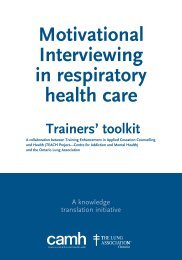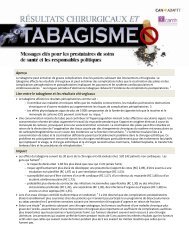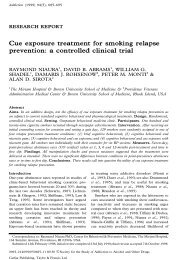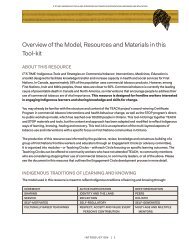SOADI Frontline Training - CAMH - Nicotine Dependence Clinic
SOADI Frontline Training - CAMH - Nicotine Dependence Clinic
SOADI Frontline Training - CAMH - Nicotine Dependence Clinic
You also want an ePaper? Increase the reach of your titles
YUMPU automatically turns print PDFs into web optimized ePapers that Google loves.
<strong>SOADI</strong> FRONTLINE TRAINING 33<br />
Smoking Youth<br />
Why are so many Aboriginal youth smoking?<br />
• Consider:<br />
• Culture (Aboriginal and non-Aboriginal).<br />
• Community, family, nation.<br />
• Media, advertising.<br />
• Economic benefits of tobacco.<br />
• Accessibility of tobacco; acceptance as a norm.<br />
• Boredom, isolation, loneliness.<br />
• Concurrent disorders (depression, substance abuse).<br />
• Peer pressure.<br />
• Or are they trying to replace something? (<strong>SOADI</strong> Grandmother,<br />
Renee Thomas Hill)<br />
Figure 29 Tobaccowise (Cancer<br />
Care Ontario, Aboriginal Tobacco<br />
Program)<br />
Impact of Tobacco<br />
What are the potential impacts (positive and negative) of<br />
manufactured tobacco on a person, their family, their community,<br />
etc.?<br />
The impacts of commercial tobacco use include:<br />
• Cigarette smoking at an early age may be a factor contributing<br />
to the high prevalence of cardiovascular disease amongst<br />
Aboriginal youth in Canada (Retnakaran et al. 2005)<br />
• The use of commercial tobacco products kills 16,000 Aboriginal<br />
people in Ontario every year (Aboriginal Cancer Care Unit<br />
2008). That means approximately two Aboriginal people die<br />
every hour of every day due to commercial tobacco use in<br />
Ontario alone!<br />
Smoking and Diabetes<br />
Did you know?<br />
• Cigarette smoking increases the risk of type 2 diabetes for all<br />
people (Foy et al., 2005; Houston et al., 2006; Carlsson et al.,<br />
2004; Sairenchi et al., 2004).<br />
• Some research suggests a linear relationship between diabetes<br />
and number of cigarettes smoked (Will et al., 2001; Houston et<br />
al., 2006); however, other studies have not found this link<br />
(Sairenchi et al., 2004; Rimm et al., 1995).<br />
• Pregnant women who smoke may also be at an increased risk of<br />
developing gestational diabetes (England et al., 2004).
















